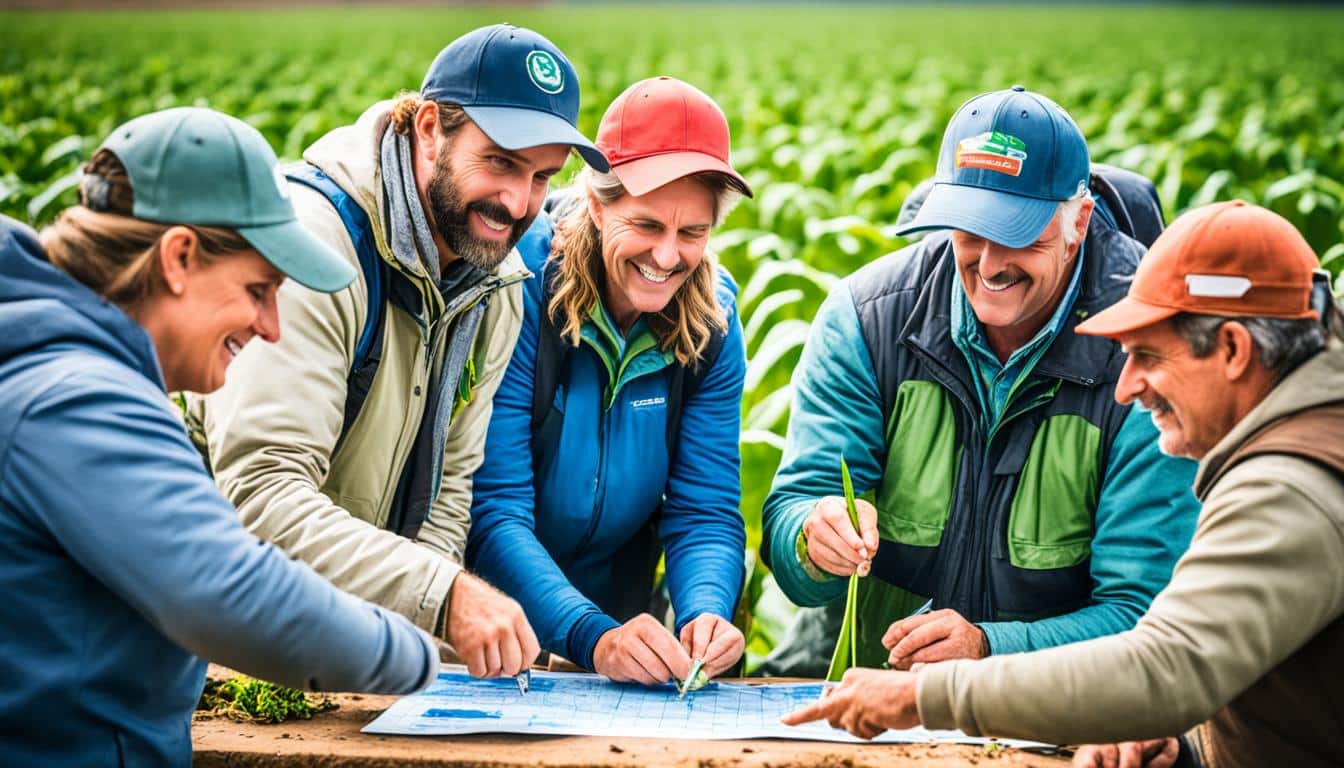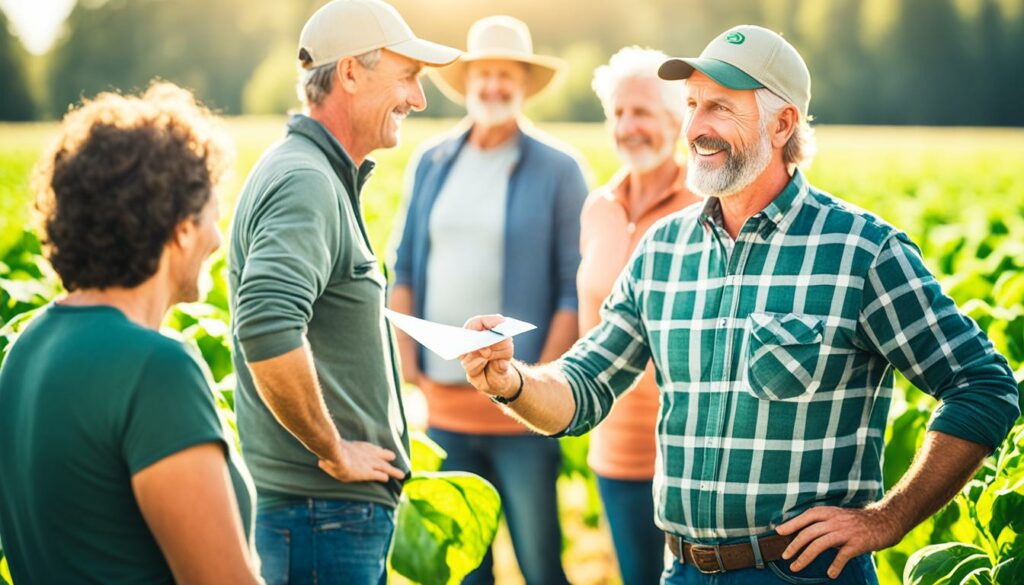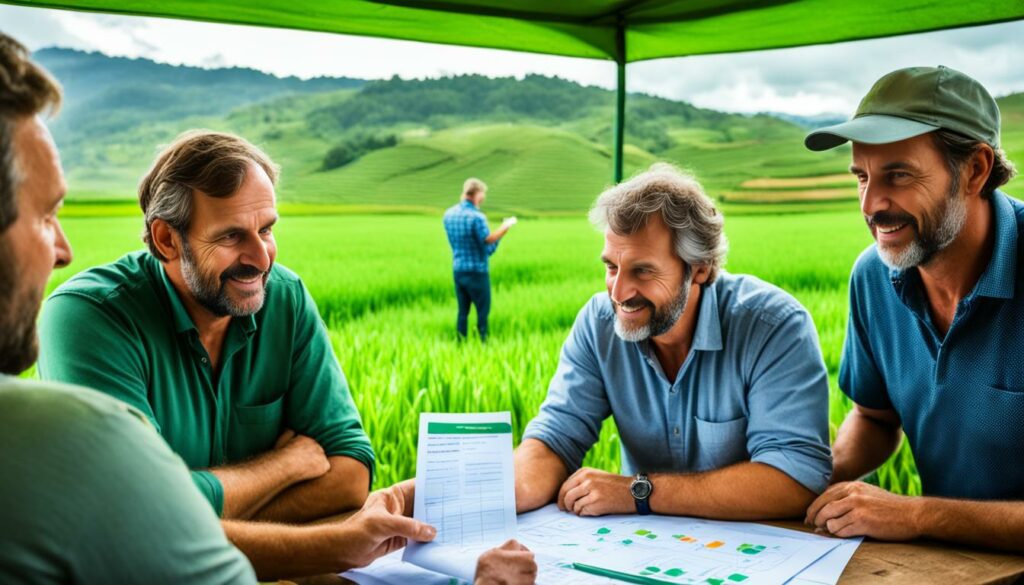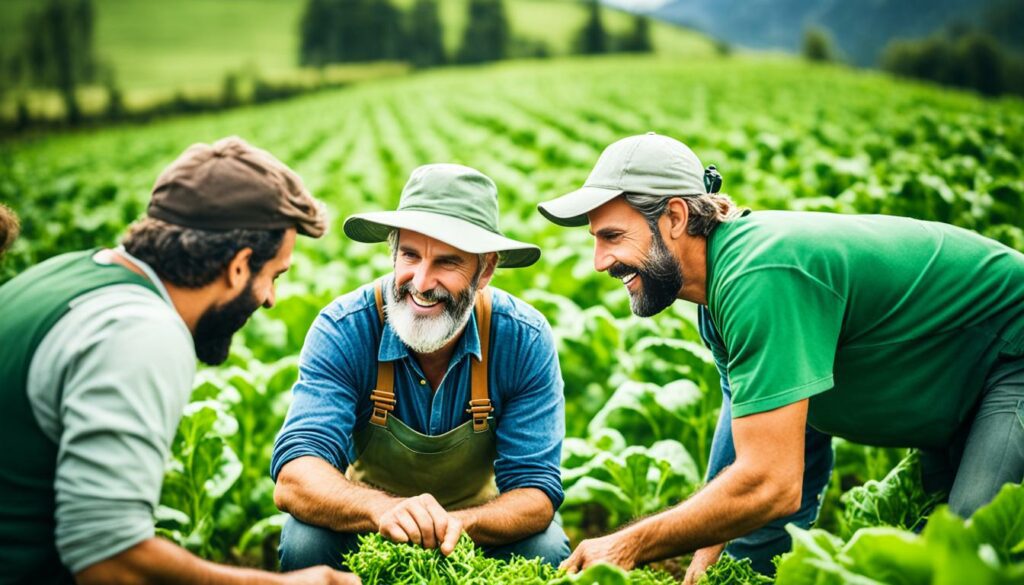Menu

Farmer-to-farmer knowledge sharing cuts costs for farmers and makes their lives better. In Bangladesh, 13 farmers visited each other to learn about growing spice seeds. They brought back seven local spice seeds, showing how sharing knowledge can change farming for the better.
On the visit, farmers learned a lot about growing seeds, taking care of the soil, keeping pests away, and using eco-friendly farming methods. This trip helped eight of the farmers decide to start growing the seeds they saw during the visit. BARCIK helped make this happen. This project highlighted how working together can help farming communities.
Transferring agricultural knowledge is key to improving farming methods today. For example, 13 farmers from Talebpur and Baira Union visited Nali village, Bangladesh. This visit showed how important it is for farmers to work together and learn from each other.
In Nali, the farmers picked up seven local spice seeds to grow on a small plot. This plot was only 10 decimal lands. This hands-on approach proved to be effective in teaching new farming techniques.
What’s more, eight of these farmers wanted to plant similar seeds after the visit. This shows how valuable farmer-to-farmer sharing is. Groups like BARCIK support such exchanges, helping farms become stronger.
In Timor-Leste, agriculture teamwork is also making a big difference. This country has a young population and it’s a model of such cooperation in Asia. The CDC in Timor-Leste is training young people in farming every year.
The CDC focuses a lot on helping women in farming and has started many youth farming groups. It sends some students to Australia for advanced training every year. By sharing its teaching methods with the government, the CDC is helping to upgrade farming in Timor-Leste in a big way.
These stories show how sharing farming knowledge can change the world. When farmers work together and learn from each other, everyone benefits. Good farming practices can spread, making agriculture better everywhere.
Agro-ecology is key in sharing knowledge between farmers. It helps in creating and exchanging green farming methods. This way, farmers can work together on better ways to farm. These methods are good for the earth and make good money. They also help whole farming communities grow.

Recent stats show that agro-ecology has 13 important rules. One rule is about farmers sharing knowledge directly. These rules help reach 15 of the 17 world goals for sustainable living. They help make sure we have enough food and help small farmers cope with hard times.
Agro-ecology is famous for cutting farming costs. This makes farmers more money. It’s good for the environment by saving water and stopping pollution. It uses water wisely, keeps soil water, and grows plants that don’t need much water.
| Key Aspect | Benefits |
|---|---|
| Economic Stability | Increased income for small-scale food producers |
| Environmental Protection | Prevents pollution and conserves water |
| Community Resilience | Enhances rural employment and livelihoods |
| Climate Change Mitigation | Reduces greenhouse gas emissions |
Also, agro-ecology helps make good jobs in the countryside. This helps young people and women. It’s especially good for those who need it most. Agro-ecology works with local people to fix problems in food systems. This gives power back to the local community.
By using new farming methods from agro-ecology, farmers improve their businesses. They build a strong and green way to farm. This fits the special needs of local farmers well. Agro-ecology helps local farmers in many ways.
“Agro-ecological principles not only enhance farmer-to-farmer knowledge sharing but also ensure sustainable agricultural practices that help conserve natural resources while fostering a resilient agricultural economy.” – High Level Panel of Experts on Food Security and Nutrition
The work in Nali Village shows us the huge benefit of sharing knowledge. By helping each other, farmers learn new ways to grow spices and farm sustainably. This project teaches us the power of working together.
Nali Village in South East Asia became focused on growing spices for a good reason. This effort was part of a larger programme that aimed to help Bangladeshi farmers use biodiversity to secure their lives. The initiative ran from 2008 to 2016.
Building on a successful model in Nepal, the programme helped small farmers, specifically helping women and improving food security. Nali used similar ideas to teach farmers about growing spices. This hands-on approach aimed at sharing knowledge.
A special visit to Nali Village let farmers try growing spices themselves. This approach led to new chances for farming growth. Let’s look at what we learned from this experiment:
The programme greatly changed how local farmers grow food. They now produce better quality food and sell it more smartly. This story from Bangladesh really shows how working with nature can better lives and support local farmers.
| Region | Focus | Impact |
|---|---|---|
| Nepal | Rice Diversity | 70 Varieties Thriving, Improved Livelihoods |
| Bangladesh | Spice Cultivation | Enhanced Seed Production, Sustainable Practices |
| Laos | Paper Mulberry Trees | Sustainable Planting, Future Demand Management |
| India | Cardamom, Tendu Leaves | Sustainable Species Planting |
By following the lessons from this case study and using eco-friendly farming, communities can do really well in farming. This means a brighter future that lasts.
Peer learning in agriculture is all about sharing new techniques and best practices. This method improves how we handle the land and care for the creatures on it. It leads to stronger teamwork among everyone in the farming world. Learning from others helps farmers use the latest methods more effectively.

Farmers learn better ways to grow crops from each other. They share what works and what doesn’t. By improving the health of the soil, they make more money. For every dollar they spend on these practices, they get back $3.
Yet, not many farmers use cover crops. Only a small portion of the land has these important plants. Peer learning is changing this. It’s teaching farmers to use cover crops and other good practices. This helps them make better crops while protecting the earth.
| Source | Practitioner | Financial Return |
|---|---|---|
| AFT Case Studies | Investments in Soil Health Practices | $3 for every $1 |
| USDA Census of Agriculture | Cover Crop Adoption | 6% of Cropland Acres |
Farmers working together become stronger. This is seen in surveys, with many farmers wanting to learn from their peers. The 2023 Farm Bill will support more learning between farmers. This will happen through special programmes that meet farmers’ needs directly.
In places like The Netherlands, where farmers first doubted peer learning, many now see its value. These peer sessions help farmers deal with new challenges. They keep their farms strong and the land healthy.
“Peer learning and farmer-to-farmer knowledge sharing are pivotal in adapting farming practices to both environmental and market changes. Engaging in collaborative efforts significantly strengthens agricultural resilience.” — Sustainable Food Trust, 2023
Peer learning makes farming better for everyone. Farmers learn from each other, making their work more productive and sustainable. This teamwork helps the farming world prepare for what’s next, making it stronger.
Knowledge exchange is key to making farming more sustainable. It allows farmers to learn from each other. They can improve how they manage soil, control pests, and use resources better. Doing this helps the environment and keeps farms productive.
The “Innovation Competition and Agricultural Show (Best Farmer 2012)” in Cambodia is a great example. It was run by GIZ. Around 1,400 people joined, and 500 farmers competed. These events showed how sharing knowledge can lead to better farming.
In May 2013, the Trans-SEC project started in Tanzania. It aims to find and try new farming methods. It uses what was learned in Cambodia to spread knowledge. By doing this, it helps farmers be more environmentally friendly.
At first, many places didn’t share farming knowledge well. This led to new projects like agricultural shows in rural Cambodia. They highlight how important it is to share what farmers know. Despite problems, like money issues and changes in the weather, sharing knowledge through the media has become a cheap way to help.
The “Best Farmer 2012” event in Cambodia showed the power of farmers sharing knowledge. It brought together 1,400 people from different villages. They shared ideas, which led to new ways of doing things in farming.
The “Best Farmer 2012” recognised the hard work of farmers. Around 500 farmers took part in a competition. They were looking to win prizes worth more than 7,000 US dollars. Even the top prize included a valuable water pump.
The Ministry of Agriculture worked with groups like the Asian Development Bank to support this. They made sure the project kept going with more events in rural areas. This way, everyone could keep learning and improving their farming methods.

Winners got to share their secrets with a big audience. They were interviewed on stage. This made their amazing work known to many people. The media also helped spread the news about their success. It praised farmers for their smart and hard work.
The event combined a competition, a show, and a festival. It brought people together and showed off local culture. Companies also got involved by giving out prizes. This gave them a chance to show their support and get noticed.
| Aspect | Statistics |
|---|---|
| Participants | 1,400 villagers |
| Competition Entrants | 500 small-scale farmers |
| Award Value | 7,000 US dollars |
| Cost per Participant | 24 US dollars |
The “Best Farmer 2012” event made a big impact in Cambodia. It showed how important it is for farmers to work together and share what they know. This leads to better and more sustainable farming. Plus, it helps recognise and celebrate the great work farmers do.
Local farmers bring key knowledge and experience to agricultural innovation. Their deep understanding and years of working the land are crucial. They help in making farming methods better. Now, many support these efforts, seeing how they boost rural areas.
A big part of making farms better involves learning together. Farmers work with others to improve technology and farming values. This teamwork helps everyone learn more. It creates ways for folks to share their ideas and goals, making progress even better.
Getting farmers to lead the way in making farms better is becoming more popular. This is because people are more interested in how farming affects the world. Local farmers are important because they know how to turn studies into real farm solutions, which can often take a long time.
Working together on new ideas isn’t just a nice thought – it brings real results. For example, the European Commission has started about 1000 projects to make farming better. By the end of 2020, over 3000 such projects are expected to take place. This shows a big interest in finding new ways to do farming.
These efforts also help different countries share what they know. This sharing is key to making farming smarter everywhere. It means encouraging researchers to work with farmers, teaching them about innovations, and showing these new ideas in real farm settings.
And, small organic farms are getting noticed for their smart farming methods. They use ways that protect nature and help against bad weather. This shows that local farmers really know how to farm in ways that last.
Local farmers are vital to making farming better and smarter. They encourage ongoing learning and working together. This not only improves rural areas but also helps farmers’ communities thrive in a changing world of farming.
| Statistic | Implication |
|---|---|
| Support for farmer-led innovation | Drives effective agricultural practices |
| 1000 Operational Groups | Highlights interest in interactive innovation projects |
| Collaborative Research Projects | Enhances cooperative approaches to problem-solving |
| Small-Scale Farms Potential | Boosts productivity and climate resilience |
Collaborative farming initiatives are powerful forces for change in the farming world. They help share knowledge and improve how we farm for the future. This creates a big impact that lasts for a long time.

In India, the Andhra Pradesh Community-Managed Natural Farming project is a stand-out example. It has helped 6 million farmers and 50 million consumers. Their crops are 11% better than those grown in the usual way. The project and others like it tackle big issues like lack of food and problems with the environment. This method fights the negative effects of climate change on farming.
Another great work is the effort in Africa. There, 200 leaders and friends worked together. They came up with plans to change markets and policies. They also wanted to make farming more sustainable. These actions help not just with growing more food but also protect the planet and help people.
In Mexico, the Sierra de Tapalpa area started a special farming project in 2021. It aimed to fight big problems like trees being cut down, the risk of fires, and not enough water. The people there are now doing farming that helps the land recover. This way of farming deals with problems now and makes the future better. It’s a win for everyone.
These joint farming projects set the basis for farming that can last. By working together and sharing what works, farmers do better. For example, special ways of farming help them earn 49% more. This is a good reason to do farming together. It helps not just one farmer but also the whole farming world and the earth.
Using new technology in farming is making these projects even more effective. Things like smart farming tools and better ways to use data are helping. They improve how much food is grown and its quality. Companies all over the world are working together to share these benefits. This means more sustainable farming practices for everyone.
To wrap up, these farming efforts are like a big push for change. They help in many ways, from making farmers’ lives better to helping the earth. By learning together and doing farming in a sustainable way, these projects bring hope for a brighter farming future.
Government action and NGO help are key for sharing agricultural knowledge. This is shown in the study in the Meisso district. It looked at 140 families. The results showed 42.9% of them started using better sesame farming because of these efforts.
Institutional support was very helpful here. It helped by providing access to things like services, loans, and places to sell the crops. Also, other farmers sharing their knowledge made a big difference. Those who started using the new farming methods were often more educated and had more access to help services than those who didn’t.
Sharing farming knowledge really makes a difference. A close look at the results showed the families who tried the new methods had more people to help, more animals, and knew more about growing sesame. They also made more money and lived near places they could sell their crops.
In places like Malawi, Uganda, and Ghana, organisations like Self Help Africa (SHA) and TRAX are showing how important it is. They show that with the government’s help, farmer training can reach even very far away places. This kind of teamwork helps all farming communities, even the ones that are hard to get to.
Also, this teamwork is vital for making Lead Farmers and Community Development Agents (CDAs) effective. They get better information to share and good seeds to give out. It shows why the government and NGOs are so important for making sure everyone gets the chance to learn new farming methods.
In the end, when the government and NGOs come together, they make great things happen. They create chances for everyone to learn important farming skills. This teamwork is at the heart of real progress in farming. It really makes a difference for all farmers, wherever they are.
Financial issues hinder farmers from sharing knowledge. For instance, those in the Cascadia Bioregion find it hard to adopt new climate change solutions. This is due to their limited funds. In Cambodia, agricultural events require a fee of 24 US dollars each. This high cost blocks many from attending.
Social media and similar tools are key to breaking these barriers. They connect farmers digitally, making sharing information easier. For example, small-scale organic farmers find such platforms useful for exchanging tips on dealing with climate change.
Another barrier is the absence of strong farmer networks. Sharing tips within these groups helps farmers locally. It lets them adapt to their changing environments. But, without these connections, important information doesn’t spread well.
Cultural differences also get in the way of knowledge exchange. Sometimes, farmers struggle to accept new ideas. Videos made by farmers for farmers can help in these situations. They share important information using pictures, making it clearer than words alone. This is especially useful in areas with low literacy levels.

| Event | Location | Participants | Cost Per Participant (USD) | Key Focus |
|---|---|---|---|---|
| Agricultural Shows (2012) | Rural Cambodia | 1,400 villagers | 24 | Local Varieties, Cultivation Methods |
| Trans-SEC Project (2013) | International | — | — | Utilising Cambodian Experience |
There are ways to tackle these challenges. Involving local leaders or getting private companies to sponsor events can help. These are steps to make knowledge-sharing events financially stable. By working on the financial, network, and cultural hurdles, we can make farmer-to-farmer exchanges more widespread and effective.
Peer learning networks becoming bigger can help share important agricultural know-how and new ideas. Projects like the NRDC’s Food Matters are key in this. They help all sorts of farming groups learn from each other.
Today, more than 20 cities work with the NRDC Food Matters to cut down on food waste. This group doesn’t just include cities. It also involves counties and local groups, offering a strong way to swap ideas. The group chats often, with talks from experts. They also have open meetings to share thoughts, happening every other month.
The NRDC wants to include even more US cities in the Food Matters group. This big effort brings more places together to fight food waste. The aim is to help cities come up with smart plans and back the use of eco-friendly farming practices.
The chance to grow peer learning is huge. Building on what’s already in place can really help improve farming ways and how communities bounce back. For anyone wanting to join this learning group, email NRDC at foodmatters@nrdc.org. You can be part of a big change toward less food waste and better farming methods.
Technology in agriculture has the power to change things, especially in how farmers share knowledge. Thanks to digital platforms and mobile tech, even the farthest farms can learn the latest. This helps spread the word about best practices.
Digital platforms are key in getting farming info out there. Farmers can find essential help and learning materials online. In Elgeyo-Marakwet County, Kenya, a special app was made on the Sapelli platform for sharing farming tips. This helped farmers use new methods and boost their results.

Bringing farming advice to people’s phones plays a big role in sharing new ideas. This method ensures everyone stays informed. In the Meisso district, sesame farmers learned a lot through talking with each other. Using digital and mobile methods, we can make sure farmers get trustworthy advice, making a stronger farming community.
| Adoption Metrics | Adopters (42.9%) | Non-Adopters (57.1%) |
|---|---|---|
| Education Level | Higher | Lower |
| Household Head | Predominantly Male | Mixed |
| Access to Extension Services | Greater | Limited |
| Market Accessibility | Closer to Markets | Farther from Markets |
In the end, using tech well in farming, like through apps and mobile help, makes a big difference. It improves how farmers learn and share tips. This leads to better farming results and stronger communities.
The story of Centro Desenvolvimento Comunitario (CDC) in Timor-Leste shows how youth-focused farming lessons are key. CDC’s work proves that teaching agriculture in a hands-on way helps make the next farmers ready. They have supported young people and made sure both males and females get equal education. Their group includes 16 men, 16 women, 16 boys, and 16 girls. This mix shows how they are training a varied group of future farming leaders.
CDC has taught 32 students, with half being girls. This fits their goal of getting young people involved in farming using lasting methods. Their work is vital, especially in places like Dili and Manatuto, where they are present. From October 1, 2021, to March 31, 2022, their work has touched many, highlighting how key open education is.
CDC’s key to success is working with others and learning together. Their team is almost 70% men and 30% women, showing they believe in fair sharing of jobs and knowledge. Both men and women help choose and do the best ways to farm. Because of their partnerships, lots of people, including youth and women, have learned how to farm better. This has not only helped teach 4,953 people but also made farming better, boosting the local economy.
In conclusion, Centro Desenvolvimento Comunitario in Timor-Leste is an example of how teaching young people about farming and working with others can make a big difference. They aim to properly equip the next generation with what they need to lead in farming. This case shows how important it is to have both girls and boys learning equally and working with partners for long-lasting farming success.
Farmers share ideas, methods, and farming techniques. This way, they all get better at what they do. It’s like learning from lots of different teachers at once.
When farmers work together, they share how to grow better crops. They also help each other when facing problems with pests or the weather. This makes farming stronger and more successful for everyone.
Agro-ecology is about farming in a way that’s good for the land. When farmers talk about these methods, they help each other use practices that protect the environment. This is key for long-lasting, healthy farming.
Working together, the farmers got hands-on lessons. They learned how to handle seeds, improve the soil, tackle pests, and make compost. This all made their spice-growing better and their farms more successful.
Peer learning is teaching each other directly, farmer-to-farmer. They swap new ideas and better ways to grow crops. This sharing makes everyone’s farming more effective and productive.
Exchanging knowledge helps farmers learn the best ways to farm that are also good for the earth. They find out about managing soil, controlling pests, and using resources wisely. This results in farms that thrive without harming the environment.
The project made big news about farming success in 2012. This drew everyone’s attention to good farming methods. As a result, more farmers used eco-friendly ways to grow food. It was a big step towards better, sustainable farming.
Local farmers know a lot about what works best in their area. They pass on their practical tips to other farmers. This sharing helps improve how all farmers grow their crops.
Projects like sharing seeds or building irrigation systems have been really important in change. They help farmers work together and learn from each other. This often leads to big, positive changes in how farming is done.
They help organise events and set up places for farmers to share ideas. Governments and NGOs work to make sure practical farming tips move around. They support the farming sector in growing better together.
Not having enough money, weak connections, and different customs can be hurdles. It’s important to solve these problems to make the most out of sharing farming knowledge. This helps farmers be more united and strong.
By making friends with more farmers and keeping in touch better, people learn a lot more. Stronger networks mean everybody can share what they know about farming. This makes farming better for the whole community.
Things like online platforms and mobile apps let farmers share tips easily, even from far away. This kind of tech makes getting advice and useful information quick and simple. It’s a big boost for farming everywhere.
The study shows how teaching young people about farming is really important. It gives them the skills they need to carry on successful farming in the future. This helps keep farming techniques alive and farms healthy in the region.